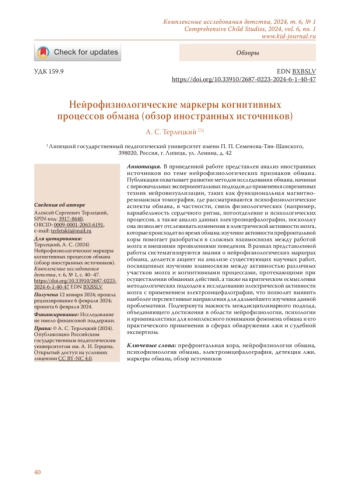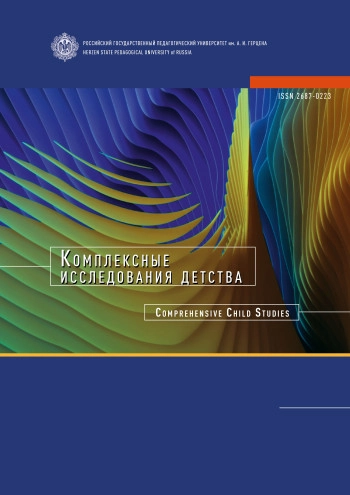1. Abe, N. (2009) The neurobiology of deception: Evidence from neuroimaging and loss-of-function studies. Current Opinion in Neurology, vol. 22, no. 6, pp. 594-600. (In English). DOI: 10.1097/WCO.0b013e328332c3cf
2. Abe, N. (2011) How the brain shapes deception: An integrated review of the literature. Neuroscientist, vol. 17, no. 5, pp. 560-574. (In English). DOI: 10.1177/1073858410393359
3. Abe, N., Suzuki, M., Mori, E. et al. (2007) Deceiving others: Distinct neural responses of the prefrontal cortex and amygdala in simple fabrication and deception with social interactions. Journal of Cognitive Neurosciences, vol. 19, no. 2, pp. 287-295. (In English). DOI: 10.1162/jocn.2007.19.2.287
4. Abootalebi, V., Moradi, M. H., Khalilzadeh, M. A. (2009) A new approach for EEG feature extraction in P300-based lie detection.Computer Methods and Programs in Biomedicine, vol. 94, no. 1, pp. 48-57. (In English). DOI: 10.1016/j.cmpb.2008.10.001
5. Ambach, W., Gamer, M. (2018) Chapter 1-Physiological measures in the detection of deception and concealed information. In: J. P. Rosenfeld (ed.). Detecting concealed information and deception recent developments. Recent developments. Evanston: Academic Press, pp. 3-33. (In English). DOI: 10.1016/B978-0-12-812729-2.00001-X
6. Bowyer, S. M. (2016) Coherence a measure of the brain networks: Past and present. Neuropsychiatric Electrophysiology, vol. 2, article 1. (In English). DOI: 10.1186/s40810-015-0015-7
7. Chikhi, S., Matton, N., Blanchet, S. (2022) EEG power spectral measures of cognitive workload: A meta-analysis. Psychophysiology, vol. 59, no. 6, article e14009. (In English). DOI: 10.1186/s40810-015-0015-7 EDN: PEMYFL
8. Constâncio, A. S., Tsunoda, D. F., Silva, H. F. N. et al. (2023) Deception detection with machine learning: A systematic review and statistical analysis. PLoS One, vol. 18, no. 2, article e0281323. (In English). DOI: 10.1371/journal.pone.0281323 EDN: SGDXNN
9. Davatzikos, C., Ruparel, K., Fan, Y., et al. (2005) Classifying spatial patterns of brain activity with machine learning methods: Application to lie detection. Neuroimage, vol. 28, no. 3, pp. 663-668 (In English). DOI: 10.1016/j.neuroimage.2005.08.009
10. Debey, E., Liefooghe, B., de Houwer, J., Verschuere, B. (2015) Lie, truth, lie: The role of task switching in a deception context. Psychological Research, vol. 79, no. 3, pp. 478-488. (In English). DOI: 10.1007/s00426-014-0582-4 EDN: HOPEEY
11. Fang, Z., Lynn, E., Huc, M. et al. (2022) Simultaneous EEG + fMRI study of brain activity during an emotional Stroop task in individuals in remission from depression. Cortex, vol. 155, pp. 237-250. (In English). DOI: 10.1016/j.cortex.2022.07.010 EDN: LFXTTD
12. Ganis, G. (2009) The cognitive neuroscience of deception. Social Neuroscience, vol. 4, no. 6, pp. 456-472. (In English). DOI: 10.1080/17470910802507660
13. Ganis, G., Kosslyn, S. M., Stose, S. et al. (2003) Neural correlates of different types of deception: An fMRI investigation. Cerebal Cortex, vol. 13, no. 8, pp. 830-836. (In English). DOI: 10.1093/cercor/13.8.830 EDN: INDIEN
14. Ganis, G., Rosenfeld, J. P., Meixner, J., Kievit, R. A. (2011) Lying in the scanner: Covert countermeasures disrupt deception detection by functional magnetic resonance imaging. NeuroImage, vol. 55, no. 1, pp. 312-319. (In English). DOI: 10.1016/j.neuroimage.2010.11.025
15. Grethlein, J. (2021) The ancient aesthetics of deception. The ethics of enchantment from Gorgias to Heliodorus. Cambridge: Cambridge University Press, 332 p. (In English).
16. Hiser, J., Koenigs, M. (2018) The multifaceted role of the ventromedial prefrontal cortex in emotion, decision making, social cognition, and psychopathology. Biological Psychiatry, vol. 83, no. 8, pp. 638-647. (In English). DOI: 10.1016/j.biopsych.2017.10.030
17. Ito, A., Abe, N., Fujii, T. et al. (2011) The role of the dorsolateral prefrontal cortex in deception when remembering neutral and emotional events. Neuroscientific Research, vol. 69, no. 2, pp. 121-128. (In English). DOI: 10.1016/j.neures.2010.11.001
18. Jiang, Z., Liu, Y., Li, W. et al. (2023) Integration of simultaneous fMRI and EEG source localization in emotional decision problems. Behavioral Brain Research, vol. 448, article 114445. (In English). DOI: 10.1016/j.bbr.2023.114445
19. Johnson, R. (2014) Chapter 6-The neural basis of deception and credibility assessment: A cognitive neuroscience perspective. In: D. C. Raskin, Ch. R. Honts, J. C. Kircher (eds.). Credibility assessment. Scientific research and applications. New York: Academic Press, pp. 217-300. (In English). DOI: 10.1016/B978-0-12-394433-7.00006-3
20. Karim, A. A., Schneider, M., Lotze, M. et al. (2010) The truth about lying: Inhibition of the anterior prefrontal cortex improves deceptive behavior. Cerebral Cortex, vol. 20, no. 1, pp. 205-213. (In English). DOI: 10.1093/cercor/bhp090
21. Krapohl, D., Shaw, P. (2015) Fundamentals of polygraph practice. San Diego: Academic Press, 348 p. (In English).
22. Lisofsky, N., Kazzer, P., Heekeren, H. R., Prehn, K. (2014) Investigating socio-cognitive processes in deception: A quantitative meta-analysis of neuroimaging studies. Neuropsychologia, vol. 61, pp. 113-122. (In English). DOI: 10.1016/j.neuropsychologia.2014.06.001
23. Meier, S. K., Ray, K. L., Mastan, J. C. et al. (2021) Meta-analytic connectivity modelling of deception-related brain regions. PLoS One, vol. 16, no. 8, article e0248909. (In English). DOI: 10.1371/journal.pone.0248909 EDN: LKCHIT
24. Merzagora, A. C., Bunce, S., Izzetoglu, M., Onaral, B. (2006) Wavelet analysis for EEG feature extraction in deception detection. In: Annual International Conference of the IEEE Engineering in Medical Biological Society. New York: Institute of Electrical and Electronics Engineers Publ., pp. 2434-2437. (In English). DOI: 10.1109/IEMBS.2006.260247
25. Ouerchefani, R., Ouerchefani, N., Rejeb, M. R. B., Le Gall, D. (2024) Pragmatic language comprehension: Role of theory of mind, executive functions, and the prefrontal cortex. Neuropsychologia, vol. 194, article 108756. (In English). DOI: 10.1016/j.neuropsychologia.2023.108756
26. Rolls, E. T., Grabenhorst, F. (2008) The orbitofrontal cortex and beyond: From affect to decision-making. Progress in Neurobiology, vol. 86, no. 3, pp. 216-244. (In English). DOI: 10.1016/j.pneurobio.2008.09.001
27. Smith, E. H., Horga, G., Yates, M. J. et al. (2019) Widespread temporal coding of cognitive control in the human prefrontal cortex. Nature Neuroscience, vol. 22, no. 11, pp. 1883-1891. (In English). DOI: 10.1038/s41593-019-0494-0
28. Suzuki, Y., Tanaka, S. C. (2021) Functions of the ventromedial prefrontal cortex in emotion regulation under stress. Scientific Reports, vol. 11, article 18225. (In English). DOI: 10.1038/s41598-021-97751-0 EDN: CLNEWP
29. Wood, J. N., Grafman, J. (2003) Human prefrontal cortex: Processing and representational perspectives. Nature Reviews Neuroscience, vol. 4, no. 2, pp. 139-147. (In English). DOI: 10.1038/nrn1033
30. Yarkoni, T., Braver, T. S., Gray, J. R., Green, L. (2005) Prefrontal brain activity predicts temporally extended decision-making behavior. Journal of the Experimental Analysis of Behavioral, vol. 84, no. 3, pp. 537-554. (In English). DOI: 10.1901/jeab.2005.121-04







